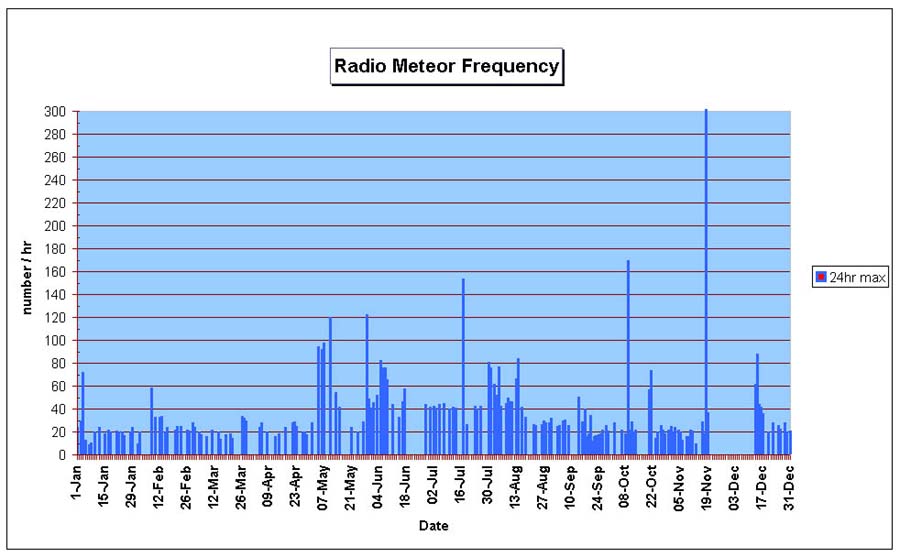
|
Radio Meteors There is one area of Astronomy that you can do day or night, rain or shine. It's the study of meteors by the reflection of radio waves. When a meteor burns up in the atmosphere it leaves a trail of ionised air that is an effective reflector of radio waves. When you tune to the frequency of a distant radio station most of the time you will hear only static hiss and crackle. However, when a meteor burns up it leaves a short-lived radio mirror that enables a stronger signal to arrive at the reciever. The usual static hiss and crackle is replaced by a brief sound bite of radio programme. The passage of meteor into the Earth's atmosphere has been detected! Measurement of the number of these sound bites that occur and calculating the maximum number per hour is known as the radio meteor rate. Spaceweather.com reports these figures most days. Below is a graph displaying data collected during 2001 and 2002. It reveals some interesting trends.
|

|
First, we see that there is a general background activity of around 20 meteors/hr (there are some gaps in the data due to me not recording the number for that day or the number was not available). This is due to weak shower activity and the contribution from sporadic meteors. There are actually many minor meteor showers during the year. Click here for more information about meteor showers. Second, there are a number of strong peaks with rates greater than 60/hr, most can be identified with known shower activity. Showers are named after the constellation, or region of a constellation, from which they appear to emanate - Leonids from Leo, Arietids from Aries, etc. The Quadrantids emanate from an ancient constellation originally known as "Quadrans Muralis", now part of Bo÷tes. The table provides identification.
|
| Date | Shower |
| 4th January | Quadrantids |
| early Feb | Aurigids? |
| early May | h Aquarids, May Piscids |
| 10th May | e Arietids (daytime shower) |
| end May | not known |
| early June | Arietids |
| mid July | not known (may be an error on my part) |
| end July | d Aquarids |
| early August | a Capricornids, northern and southern i Aquarids |
| 12 August | Perseids |
| 9th October | Draconids |
| 20th October | Orionids |
| 18th November | Leonids (storm levels greater than 500m/hr) |
| 13 December | Geminids |
|
Notes:
|
Meteor Home